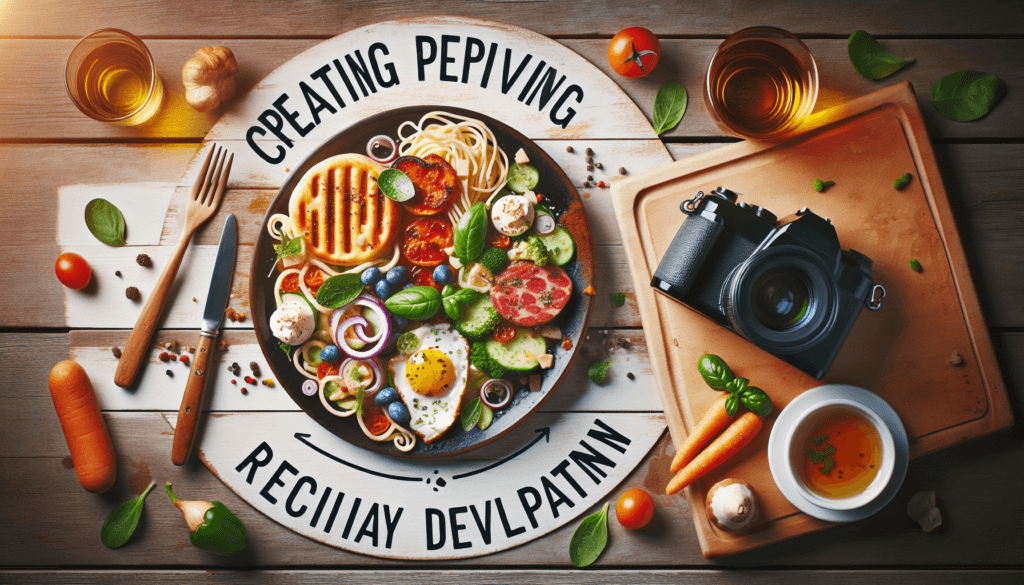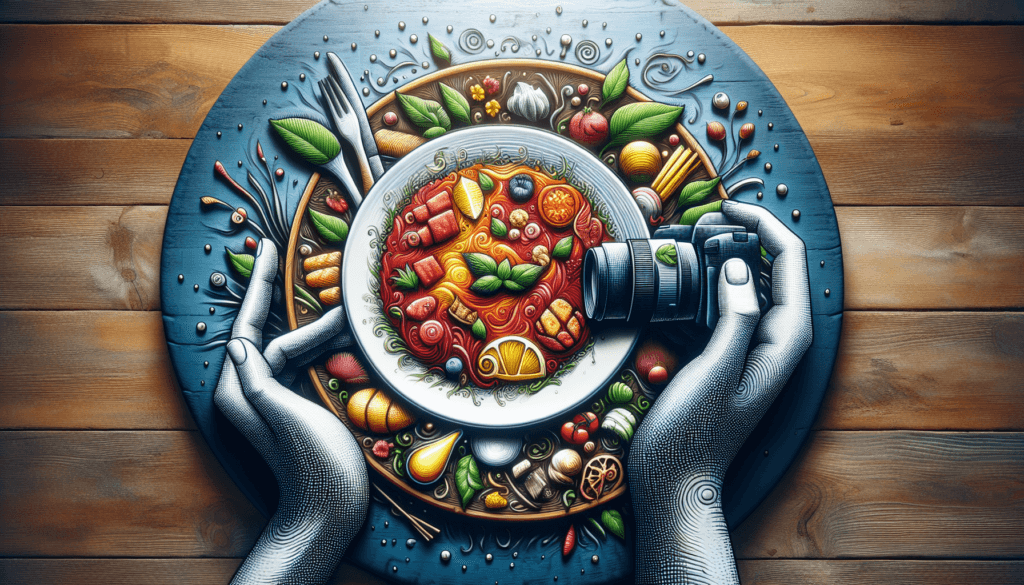Imagine being able to share your love for cooking and food with the world. With the Ultimate Guide to Blogging for Food and Recipes, you’ll learn everything you need to know to start your own successful food blog. From creating mouthwatering recipes to taking stunning food photography, this comprehensive guide will walk you through each step of the process. Whether you’re a seasoned chef or just someone who enjoys experimenting in the kitchen, this guide will help you turn your passion for food into a thriving online community. Get ready to tantalize taste buds and inspire fellow food enthusiasts as you embark on this delicious blogging journey.

Choosing a Niche
When starting a food and recipe blog, it’s important to choose a niche that not only aligns with your own interests and expertise but also resonates with your target audience. Determining your target audience will help you create content that caters to their needs and preferences. Are you targeting health-conscious individuals, busy parents, or aspiring chefs? Understanding who you are speaking to will guide your content creation process.
Identifying your unique selling point is another crucial aspect of choosing a niche. What sets your blog apart from the multitude of food and recipe blogs out there? Do you specialize in a specific cuisine, dietary restriction, or cooking technique? This unique angle will make your blog stand out and attract a dedicated following.
To ensure your blog’s long-term success, it’s essential to research popular and profitable niches. Explore what topics currently have a strong demand in the food and recipe blogging world. Look for niches that combine your passion with market viability. By choosing a niche with enough potential for growth and monetization, you can lay a solid foundation for your blog’s success.
Setting Up Your Blog
Once you have determined your niche, it’s time to set up your blog. The first step is choosing a domain name that represents your brand and is easy for your audience to remember. Consider using keywords relevant to your niche in your domain name to help with search engine optimization.
Next, select a hosting platform that can handle the traffic and storage needs of your blog. Look for a reliable provider that offers responsive customer support and easy scalability as your blog grows.
Installing a content management system (CMS) is essential for managing and organizing your blog’s content. Popular CMS options include WordPress, Blogger, and Squarespace. Choose a CMS that aligns with your technical skills and offers the features you need to create and manage your blog effectively.
Customizing your blog’s design is where your creative flair comes into play. Choose a visually appealing theme or hire a web designer to create a unique look that reflects your brand. Consider the functionality of your blog’s design, making it user-friendly and easy to navigate.

Creating Quality Content
The success of your food and recipe blog ultimately depends on the quality of your content. Developing a content strategy will help you consistently create engaging and valuable posts that resonate with your audience. Plan out the types of content you want to produce, such as recipes, cooking tips, product reviews, or personal anecdotes.
Writing compelling blog posts is an art form. Use storytelling techniques, descriptive language, and a conversational tone to captivate your readers. Share personal experiences, tips, and tricks to make your content relatable and useful.
Including high-quality images and videos in your blog posts can enhance the visual appeal and engage your readers. Invest in a good camera and learn basic photography techniques to capture mouthwatering food photos. Consider adding instructional videos or behind-the-scenes footage to provide additional value to your audience.
Optimizing your content for search engines is crucial for attracting organic traffic. Research relevant keywords and incorporate them naturally into your blog posts. Pay attention to meta tags, alt text for images, and proper formatting to help search engines understand and rank your content.
Photography Tips
Creating visually stunning food photography is essential for captivating your audience and enticing them to try your recipes. Investing in a good camera and lenses can significantly improve the quality of your photos. Consider a DSLR camera with a macro lens to capture intricate details and vibrant colors.
Understanding lighting and composition is key to creating visually appealing photos. Utilize natural light whenever possible, positioning your subjects near windows or shooting outdoors. Experiment with different angles, props, and backgrounds to create interesting compositions that highlight the food.
Editing and enhancing your food photos can elevate their impact. Use photo editing software like Adobe Photoshop or Lightroom to adjust brightness, contrast, and color balance. Apply filters or presets to create a consistent and cohesive aesthetic for your blog.

Recipe Development
Creating delicious and reliable recipes is at the heart of a food and recipe blog. Experiment with ingredients and flavors to develop unique and flavorful dishes. Explore various cooking techniques and culinary traditions to bring diversity to your recipes.
When writing recipe blog posts, provide step-by-step instructions that are easy to follow. Break down each cooking process into clear and concise steps, with specific measurements and timings. Consider incorporating visual aids, such as photos or videos, to guide your readers through the recipe.
Providing nutritional information is essential for readers with dietary restrictions or health-conscious lifestyles. Calculate the calorie, macronutrient, and allergen content of your recipes using online tools or nutrition software. Display this information in a clear and easily accessible format.
Testing and refining your recipes before publishing them is crucial to ensure their accuracy and taste. Cook the recipe multiple times, making adjustments as needed. Take note of any potential challenges or modifications that readers might encounter and provide helpful tips and alternatives.
Building Your Brand
Creating a strong brand identity will help your food and recipe blog stand out in the competitive blogging industry. Start by creating a memorable blog name and designing a unique logo that represents your brand’s essence. Your blog’s name and logo should be visually appealing and easily recognizable.
Defining your brand’s personality and voice will influence the tone of your writing and the overall feel of your blog. Are you fun and playful, or more formal and informative? Understanding your brand’s personality will help you connect with your audience on a more personal level.
Building a consistent brand image across all platforms is key to solidifying your blog’s identity. Use consistent colors, fonts, and imagery on your blog, social media profiles, and promotional materials. This cohesive look will help build brand recognition and foster trust with your audience.

Engaging with Your Audience
Engaging with your audience is vital for building a loyal following and fostering a sense of community around your blog. Encourage comments and feedback on your blog posts to create a two-way conversation. Respond promptly and thoughtfully to reader inquiries, comments, and suggestions.
Organizing giveaways and contests can be a fun way to incentivize readers to engage with your blog. Offer prizes related to your niche, such as cooking utensils or specialty ingredients. Encourage readers to participate by sharing your content or submitting their own recipes.
Promoting Your Blog
Promoting your blog is essential for driving traffic and growing your audience. Utilize social media platforms to share your blog posts and engage with your followers. Choose platforms that align with your target audience and utilize social media management tools to schedule posts and analyze performance.
Collaborating with other bloggers and influencers in your niche can expand your reach and introduce your blog to new audiences. Partner with like-minded individuals for guest posts, recipe swaps, or joint giveaways. This mutually beneficial partnership can help attract new readers and build valuable relationships.
Joining online communities and forums can also be an effective way to promote your blog. Participate in discussions related to your niche and share your expertise to establish yourself as a trusted authority. Leave helpful comments on other blogs or forums and include a link back to your own blog when appropriate.
Optimizing your blog for search engine optimization (SEO) is crucial for driving organic traffic to your blog. Research relevant keywords and incorporate them naturally into your blog posts, headings, and meta tags. Improve your blog’s loading speed, ensure mobile responsiveness, and create descriptive URLs to improve your search engine rankings.

Monetizing Your Blog
Once your food and recipe blog has gained a significant following, there are various ways to monetize your content. Displaying ads on your blog can provide a steady stream of passive income. Join an advertising network like Google AdSense or partner with brands directly for sponsored content opportunities.
Creating and selling digital products related to your niche can be a lucrative source of income. Develop e-books, meal plans, or cooking courses that offer unique value to your audience. Utilize e-commerce platforms or plugins to sell your digital products directly from your blog.
Offering recipe development and consulting services can leverage your expertise and reputation as a food blogger. Collaborate with restaurants, food brands, or aspiring chefs who can benefit from your recipe development skills. Provide personalized consultations and assistance tailored to their specific needs.
Legal and Ethical Considerations
As a food and recipe blogger, it’s essential to understand and adhere to legal and ethical considerations. Familiarize yourself with copyright laws and recipe attribution guidelines to ensure you are giving proper credit to original sources. Avoid plagiarism and provide clear references when using others’ recipes or images.
Disclosing sponsored content and affiliations is necessary to maintain transparency with your audience. Clearly label sponsored posts or when you receive compensation for promoting products or brands. This transparency builds trust with your readers and complies with regulatory guidelines.
Protecting user data is crucial for maintaining the privacy and security of your audience. Follow best practices for data protection and ensure compliance with privacy regulations such as GDPR. Use secure hosting and implement proper encryption and safeguards to safeguard user data.
Ensuring transparency in reviews and recommendations is vital for maintaining the integrity of your blog. Clearly state whether a product or service was provided for free or at a discounted rate for review purposes. Offer unbiased and honest opinions, highlighting both the pros and cons, to provide genuine value to your audience.
By following these comprehensive steps, you can create a successful food and recipe blog that engages your audience and showcases your passion for cooking. Remember, blogging is a journey, so be patient, stay consistent, and continue to learn and grow as a blogger. Happy blogging!


